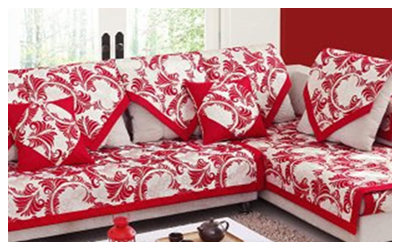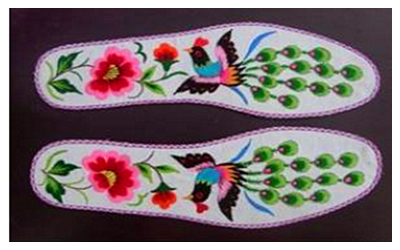
Cloth-piecing art is said to be rooted in folk crafts in India. Artworks then mostly consisted of apparel and scarves, where patterns and color matching were formed in accordance with local religious customs. In the 12th and 13th centuries, when Europe fell prey to frequent cold snaps, people began making bedclothes by cloth piecing to stay warm. At the time, cloth-piecing techniques were more decorative rather than practical.
In the 17th century, as a result of the discovery of the New World, many European puritans immigrated to America, bringing with them the art of cloth piecing. From then on, the art has spread throughout the world.
By the middle of the 19th century, cloth-piecing art had become an international trend. Although the materials consisted of scraps of cloth, the art had developed form a utility to a handicraft art.
The basic tools for cloth piecing are: a canvas and palette, scissors, pen, bead needle, ruler, needle, thread, thimble, seam ripper, embroidery border, awl, gyro wheel and paper . The basic materials include thin silk, velour, fine knops, cloth of various kinds, fasteners, etc. To master the art of cloth piecing, one has to acquaint him/herself with drawing basic pictures, color-matching, types and characteristics of cloth, tools and cloth clipping, etc. Cloth-piecing works can be used as cushions, frescos, pillows, baskets, furniture and ornaments.
Cloth Home Furnishings
Compared to other types of furnishings, cloth furnishings are more substantial and convenient. For example, if you change the color of your curtains and bedspread in the bedroom, the whole bedroom will take on a brand new look.
The living room

Set off by the cool-colored furniture and white walls, the living room can be decorated with bright-colored cloth artworks, such as red, orange and blue. Coordinated with bright, cool, cold and warm colors, the whole room can become more harmonious.
1. A piece of cloth can change the face of a sofa:
If the slipcover cannot be removed from the sofa, a piece of cloth can be used to cover the surface. For example, a piece of cloth with a rustic pattern that can cover the whole sofa will make it seem more casual and comfortable.
2. Same colors, different designs:
Two single cloth sofas of the same type and color can be made to look more distinct by employing different pattern designs, which can be applied in making flower-pattern cloth.
3. For a low-key lifestyle:
If you prefer a low-key lifestyle, you can build a small lounge in the living room by yourself. A corner by the French window, with a cotton rug on the floor, several cushions and pillows and a low coffee table, can make for a very comfortable reading and resting spot.
4. Creative way to use rugs:
Overlapping different rugs is another way to change the living room atmosphere. For example, a red rug the size of a coffee table can be spread on top of a white rug. Pay close attention when matching rugs of different sizes.
The Bedroom
Cloth of different colors can also be used to create different atmospheres in the bedroom. A red woolen rug with a red gauze curtain and other red decorations can create a joyous wedding mood. On the other hand, a yellow or green bedspread can make one feel like spring is in the air.
1. Bed cloth art:
The most common way to change the face of a bedroom is to change the bedspread. A blue bedspread with geometric designs can add a feeling of comfort and calmness.
2. Romantic bed curtain:
A gauze curtain hanging over the bed from the ceiling to the floor makes the bedroom seem warmer and more inviting, as well as romantic. There are several ways to affix the gauze curtain: One way is to roll the curtain into a ball and hang it on either side of the bed; another is to affix a shaft from the ceiling to form a right angle with the headboard, and then string the bed curtain through the shaft.
3. Roman curtains -- a brand-new view:
Roman curtains can also create a distinctive flavor in the bedroom; they can also be used on the balcony.
4. A curtain of complementary colors:
Since two parts of a curtain of the same material and design can appear somewhat dull, it may be a good idea to hang up two different curtains. This way, the contrasting curtains can create three different feelings.
Dining Room
Cloth art can give the dining room an entirely new look without changing the furniture. Keeping the functions of the dining room in mind, the cloth used here should be burly and easy to wash.
1. Use of two tablecloths for important get-together:
For a more formal and solemn look, place two tablecloths of complementary colors across the table.
2. Creative arrangement of tablecloths:
Placing three tablecloths over the dining table will give the table a clear and lively appeal.
3. Decorating the dining room cabinet:
From you collection of cloth artworks, hang two long cloth lists along the wall to the dining cabinet and then place the original decorations on the cabinet surface. This way, a smart new curtain wall will take shape.

 Cloth art offers the art on the cloth. Chinese Cloth Art is a magnificent and important part of Chinese folk art. In the ancient Chinese agricultural society, the industrious and intelligent Chinese women poured their beautiful emotions into the sewing of needles and threads, creating countless touching works of fabric.
Cloth art offers the art on the cloth. Chinese Cloth Art is a magnificent and important part of Chinese folk art. In the ancient Chinese agricultural society, the industrious and intelligent Chinese women poured their beautiful emotions into the sewing of needles and threads, creating countless touching works of fabric. Cloth-piecing art is said to be rooted in folk crafts in India. Artworks then mostly consisted of apparel and scarves, where patterns and color matching were formed in accordance with local religious customs. In the 12th and 13th centuries, when Europe fell prey to frequent cold snaps, people began making bedclothes by cloth piecing to stay warm. At the time, cloth-piecing techniques were more decorative rather than practical.
Cloth-piecing art is said to be rooted in folk crafts in India. Artworks then mostly consisted of apparel and scarves, where patterns and color matching were formed in accordance with local religious customs. In the 12th and 13th centuries, when Europe fell prey to frequent cold snaps, people began making bedclothes by cloth piecing to stay warm. At the time, cloth-piecing techniques were more decorative rather than practical.  Set off by the cool-colored furniture and white walls, the living room can be decorated with bright-colored cloth artworks, such as red, orange and blue. Coordinated with bright, cool, cold and warm colors, the whole room can become more harmonious.
Set off by the cool-colored furniture and white walls, the living room can be decorated with bright-colored cloth artworks, such as red, orange and blue. Coordinated with bright, cool, cold and warm colors, the whole room can become more harmonious.  Ask Questions ?
Ask Questions ?